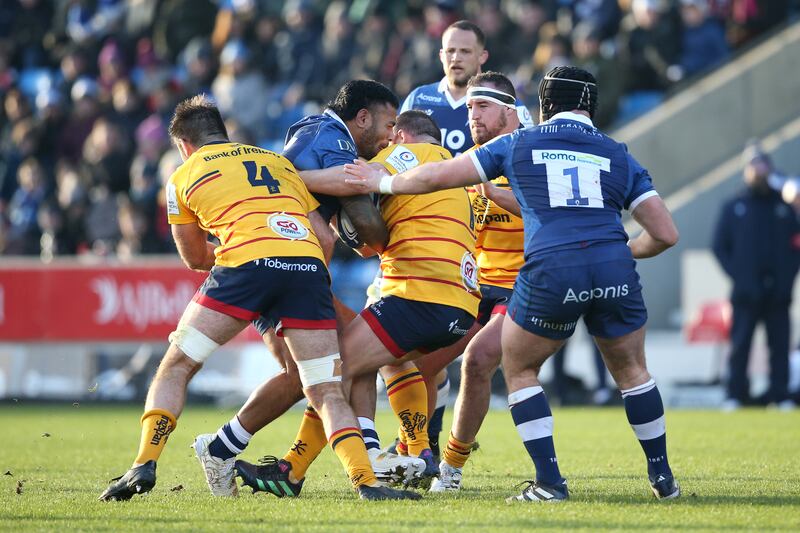When the upright tackle becomes a feature of one of the best defensive outhalves in world rugby, it will always have a say in the Irish rugby narrative. Johnny Sexton reading lines and dominating collisions by holding players up, so that others can strip the ball, has become a valuable asset to Leinster and Ireland. But it has come at a physical price.
A statement will be made today by Leinster as to whether the injury to Sexton’s face that forced him out of last Sunday’s URC league match, and sustained while making a second-half defensive tackle against Connacht’s Jarrad Butler, has resulted in a broken bone.
Afterwards, Leinster said, the captain was in good spirits and talking in the changing room but would need an X-ray. Sexton had a visible bruise on his cheek where the players’ heads collided. “A fair old whack on the cheek,” coach Leo Cullen called it.
With Gloucester less than two weeks away, Racing ‘92 a week later and the Six Nations Championship around the corner, Sexton’s status is of concern to both Irish coach Andy Farrell and Leinster’s Cullen.
RM Block
Upright tackling has itself also appeared in the dock and become an issue. Injuries because of the technique, as well as player sanctions, have become commonplace. Recently red cards have been shown and then reversed, and head-to-head contact where there was no injury to the offended player has resulted in yellow cards.
Other incidents such as Sexton’s contact with the Connacht backrow in Sunday’s match resulted in no card sanctions for either player.
“There is a process,” says Cullen. “World Rugby have a process in place. EPCR have a process. So, the referee has a checklist to go through, that’s readily available. So, it’s sticking to the process, and the process makes sense.”

It might make sense. But the outcome in terms of sanction or no sanction is not always clear. At the coaching level there is confusion between the understanding of players, referees and citing officials and the connection between the three groups as to what is dangerous and who is causing the danger, the player with the ball or the person making the tackle.
“There seems to be a serious disconnect there,” says Cullen. “We sometimes scratch our heads as well, so there’s definitely a bit of disconnect there.”
The Leinster coach can make sense of the various mitigations such as the tackler making a definite attempt to change height in an effort to avoid the ball carrier’s head or the ball carrier suddenly dropping in height. The question is whether all stakeholders sees it through the same lens and the process is clear.
“Just about, yeah. But again, I’m not sure how connected, say, the citers are with the referees,” says Cullen. “The game is dynamic though, isn’t it? Guys coming on to the ball at speed, sometimes some of these head-on collisions, the ball-carrier is low to the ground, so it’s hard when you’re in the post-match because there’s multiple images that are going through my head.
“Obviously we’ve had a red card here and it’s deemed to be probably a yellow card postgame [Cian Healy v Ulster]. Then the following week Ulster have their own scenario in a game which doesn’t get penalised, and the guy gets three weeks [Andy Warwick v Sale]. So, there’s a fair bit of inconsistency, at the moment, for incidents that are not the exact same, because there’s probably changes of direction in both of those. So, there’s multiple factors.”

While the debate over who is at fault continues, there has been a high tariff. Sexton has been using the technique for years and has been caught by head-on-head or head-on-shoulder and head-on-arm contact several times.
He knows better than anyone what works for him and sees the risk-reward equation working in his favour, although if the X-ray shows any bone fracture to his face, the first few matches of the Six Nations Championship could be in jeopardy.
[ Explained: Why the URC overturned Cian Healy’s red cardOpens in new window ]
Ireland face Wales in Cardiff in their first match on February 4th in the Principality Stadium and seven days later host France in Dublin. In that sense, the collision with Butler could be costly.
“Yeah exactly,” says Cullen. “I do think there’s ball-carriers ... they know they’ve got all the aces really, haven’t they? The ball-carrier is the one in control, so if I’m ball-carrier, I can run directly at you headfirst and that can come into the game as well. So, it’s just trying to get the right balance. A busy time for the lawmakers.”
It is unfortunate timing for the 37-year-old playmaker. Sexton missed two of Ireland’s three November internationals with injury and Sunday night was his first start for Leinster since a win against Munster on October 22nd.


















